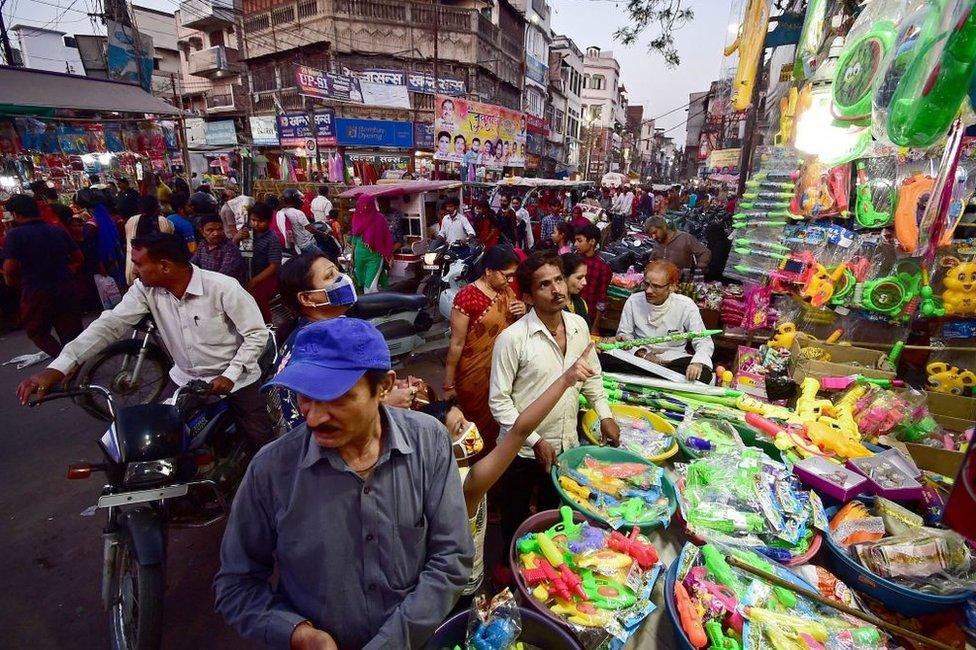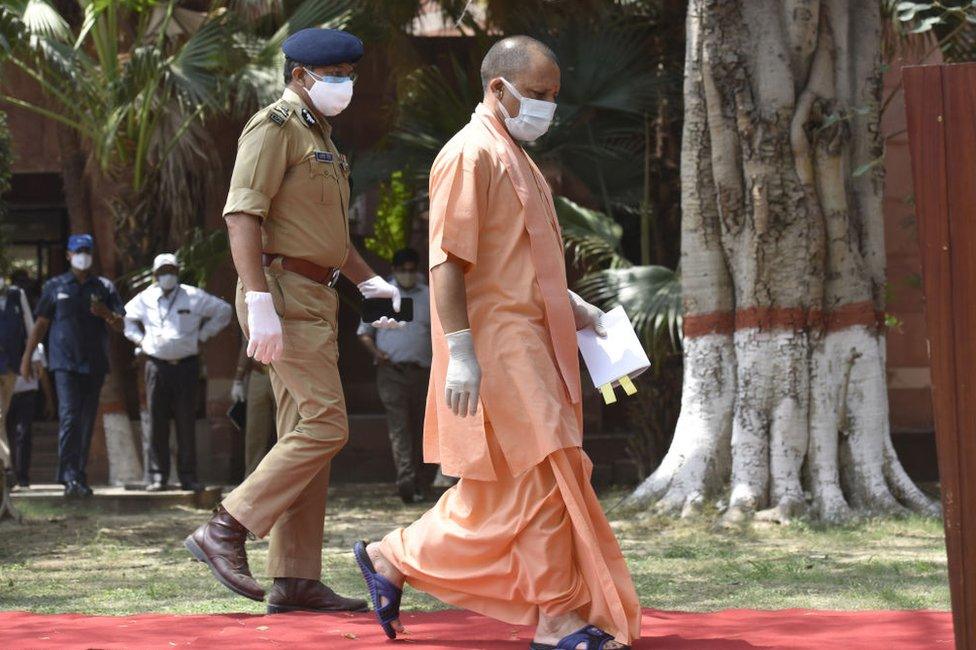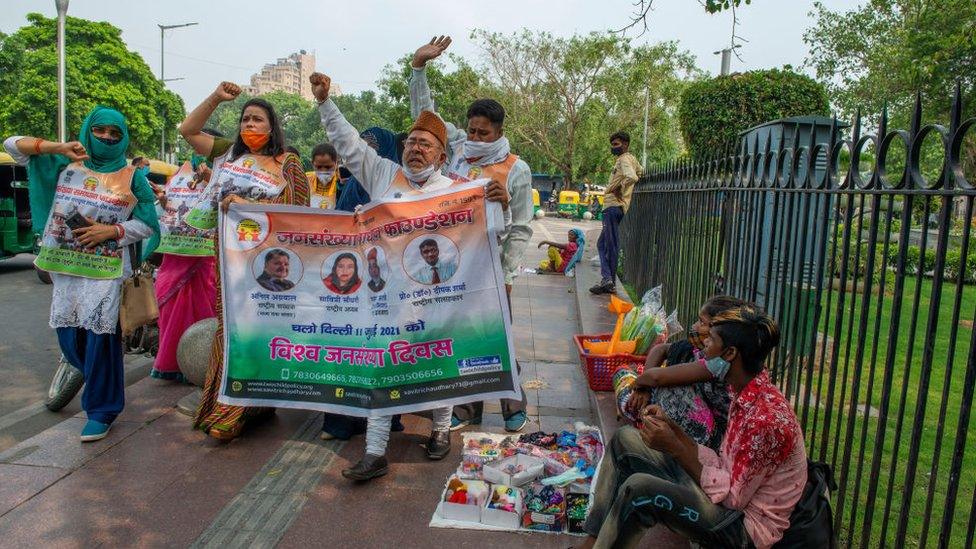Uttar Pradesh bill: The myth of India's population explosion
- Published

More than 220 million people live in Uttar Pradesh, India's most populous state
Uttar Pradesh, India's most populous state, has unveiled a controversial bill for curbing population growth.
It proposes denying government jobs, promotions, subsidies and the right to contest local elections to anyone who has more than two children.
UP, which is home to over 220 million people, has long been a governance challenge and has consistently ranked low on development indices.
But experts say its population growth - like India's - is already slowing.
Experts have warned against a "coercive" two-child policy that denies women agency and further increases unsafe or sex-selective abortions, given the deep-rooted and overwhelming preference for sons.
They are baffled by the bill, which has been drafted by the state's law commission, since it contradicts Uttar Pradesh's (UP) population control policy which was also released on Sunday.
"The bill runs counter to an overarching population policy that addresses a wide range of issues including adolescent sexual and reproductive health, child and maternal mortality, and ageing," said Poonam Muttreja, executive director of Population Foundation of India.
Does UP even need a two-child rule?
Not really, experts say.
Official counts show India's population is not exploding - on average, women in most states have been having fewer children than before, effectively flattening the growth curve.
"UP has an 18% unmet need for contraception - instead of disempowering women further, we should be ensuring that they have access to a wide basket of contraceptive devices," Ms Muttreja said.
UP's fertility rate nearly halved from 4.82 in 1993 to 2.7 in 2016 - and it's expected to touch 2.1 by 2025, according to a government projection.
Given the falling rates, "incentivising sterilisation is counterproductive", Ms Muttreja added, because "70% of India's increase in population is going to come from young people. So, what we need is non-permanent, spacing methods".
Fertility rates have dipped below replacement levels - 2.1 births per woman - in 19 out of India's 22 states and federally administered territories for which data has been released in the latest National Family Health Survey (NFHS). Data from the remaining nine states, including UP, is not ready yet.

India's population is expected to peak between 1.6 and 1.8 billion around 2060
Increased awareness, government programmes, urbanisation, upward mobility and greater use of modern methods of contraception have all contributed to this.
Nearly half of the world's countries have seen an extraordinary decline in fertility rates. By 2070, the global fertility rate is expected to drop below replacement levels, according to the UN, external.
China's fertility rate had dropped to 1.3 in 2020, while India's was 2.2 at the last official count in 2016.
So, why implement this rule now?
One reason, according to demographers, is the differing rates across India.
Six states - Uttar Pradesh, Bihar, Chattisgarh, Jharkhand, Rajasthan, Madhya Pradesh - that are home to roughly 40% of India's population also have fertility rates higher than the replacement level, 2.1. This is in sharp contrast with Kerala (1.8), Karnataka (1.7), Andhra Pradesh (1.7) or Goa (1.3).
"Also, our cities are overcrowded and ill-planned. They convey an image of over-population," Dr KS James, director of International Institute of Population Sciences, said.

Mr Adityanath has been a divisive figure
Political analysts also believe UP's chief minister, Yogi Adityanath, has an eye on state elections slated for next year. And, with such a drastic move, he hopes to signal a development agenda that is removed from his controversial image as a divisive right-wing Hindu nationalist.
This is not a new idea either. In 2018, more than 125 MPs wrote to the president asking for the implementation of a two-child norm. The same year the Supreme Court dismissed several petitions, external seeking population control measures as it could lead to a "civil war-like situation". In the last year, three MPs from Mr Adityanath's governing Bharatiya Janata Party (BJP) introduced bills in parliament to control population.
Since the early 1990s, 12 states have introduced some version of the two child-policy.
Did it work?
It's hard to say because different states implemented different versions of it - some left loopholes and others introduced financial incentives alongside the punitive measures.
There has been no independent evaluation either but a study in five of the states, external showed a rise in unsafe and sex-selective abortions, and men divorcing their wives or giving up their children for adoption so they could contest polls.

Population control measures enjoy some support in India
But the results are mixed - four states revoked the law; Bihar started in 2007 but still has the country's highest fertility rate (3.4); and Kerala, Karnataka and Tamil Nadu have all seen a remarkable drop in fertility rates with no such norms in place.
"India is at a perfect stage as far as population distribution is concerned," Niranjan Saggurti, director of the Population Council's office in India said.
Experts say India has entered a demographic dividend - the ability of a young and active workforce to catapult economies out of poverty. How India can harness this, especially in populous states like Uttar Pradesh, remains to be seen.
"We need to invest in education and health systems," Ms Muttreja said. "We can learn from Sri Lanka, which increased the marriageable age for girls, or from Bangladesh and Vietnam, which enabled a basket of non-permanent contraceptives to reach women on their doorstep."

The community radio station fighting fake news in India

Related topics
- Published23 July 2011
- Published8 July 2021
- Published12 July 2011